Coronavirus Patients Breathing in an Airplane Simulation
$120.00 Student Discount
- The problem numerically simulates Corona Virus Patients Breathing in an Airplane using ANSYS Fluent software.
- We design the 3-D model with the Design Modeler software.
- We Mesh the model with ANSYS Meshing software, and the element number equals 1316384.
- We use the DPM to study virus particles Discretely in a continuously fluid space.
To Order Your Project or benefit from a CFD consultation, contact our experts via email ([email protected]), online support tab, or WhatsApp at +44 7443 197273.
There are some Free Products to check our service quality.
If you want the training video in another language instead of English, ask it via [email protected] after you buy the product.
Description
Coronavirus Patients Breathing in an Airplane CFD Simulation, ANSYS Fluent Tutorial
In this project, based on the CFD method and using ANSYS Fluent software, an attempt has been made to simulate the respiration of viral air from the mouths of several patients carrying coronavirus in the aircraft.
This model includes a computational domain in the form of an airplane and the seats inside it, each of which a passenger is modeled. For each of these passengers, a surface is defined as the mouth as the source of respiration and transmission of the coronavirus.
The coronavirus (COVID-19) is currently recognized as the greatest human challenge in the world; Because this disease, in addition to being dangerous to human health, has a high transmission power between sick people and healthy people.
Breathing of a patent person without a mask into an enclosed space can transmit the disease to nearby people. One of the important recommendations of doctors regarding preventing disease transmission between people is to maintain social distancing in different places, including public transportation.
For example, the short distance between the passenger seats of an airplane can increase the likelihood of transmitting coronavirus from a carrier to other nearby people.
The purpose of this study is to investigate the transmission of the coronavirus between passengers caused by breathing at short distances.
According to the selection of this model, the wet particles of the virus with a density of 1000 kg.m-3 and a specific heat capacity of 1680 j/kg.K and a viscosity of 0.000172 kg/m.s and a droplet surface tension of 0.03 n/m is secreted from the patient’s mouth while breathing.
The air conditioning and air circulation system inside the aircraft is such that fresh air flows as a continuous fluid from the part installed on the airplane’s ceiling with a speed of 2.36 m/s and a temperature of 292.65 K.
Also, two parts installed on both sides of the aircraft have a speed of 0.3 m/s and a temperature of 292.65 K and enter from the installed sections under the seat of each passenger of the aircraft with a speed of 0.59 m/s and a temperature of 292.65 K; While the old airflow inside the airplane exits the two outlets on the lower two sides of the aircraft to the outside environment with a pressure equivalent to atmospheric pressure.
The present model is designed in three dimensions using Design Modeler software. The model meshing has been done using ANSYS Meshing software, and the mesh type is unstructured. The element number is 1316384.
Methodology
For the present simulation, the discrete phase model (DPM) is used; Because this model allows us to study a mass of particles discretely in a continuous fluid flow.
In this model, the virus particles are defined as INERT particles, and the injection type is SURFACE and through the inner surface of the mouth of each passenger (inlet-mouth).
According to this definition of injection, virus particles have a diameter of 0.000001 m, a temperature of 308 K, a velocity of 0.05 m/s, and a flow rate of 0.0000221 kg/s.
Coronavirus Patients Breathing in an Airplane Conclusion
At the end of the solution process, coronavirus particle tracking is obtained based on residence time, as well as three-dimensional contours of temperature and air velocity inside the airplane.
As is clear from the contours, the purpose of this project is well met. The particles come out of the human mouth and affect the mainstream of the fluid.

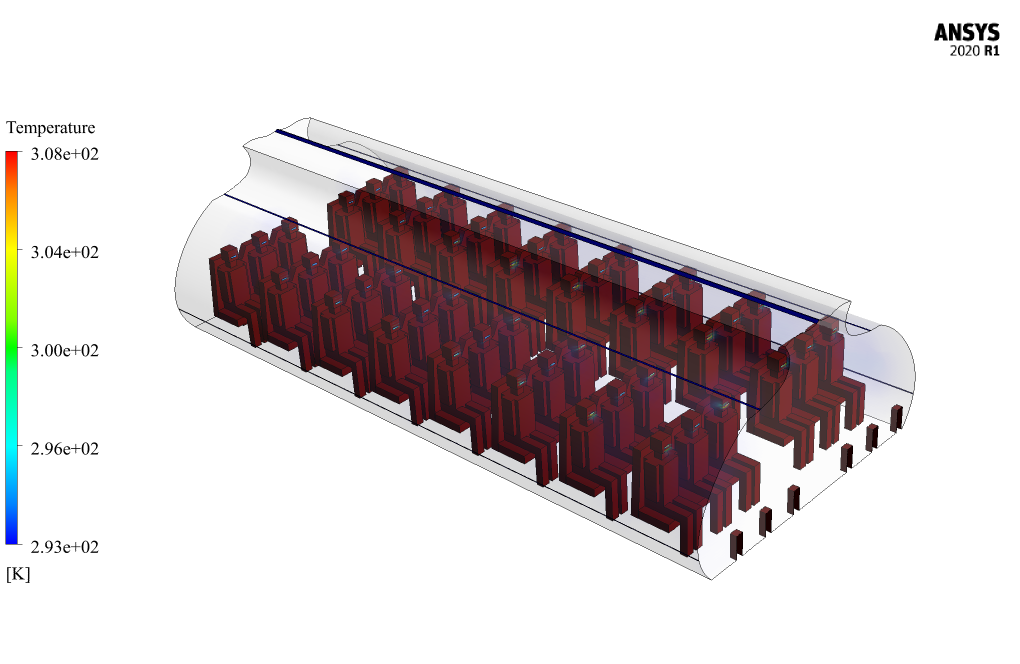
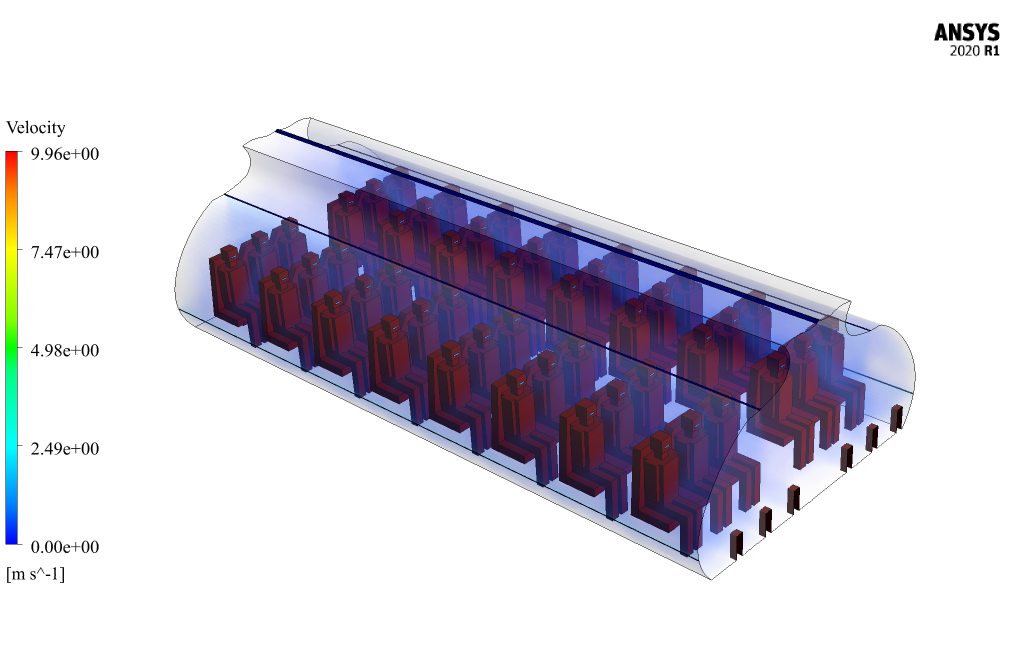
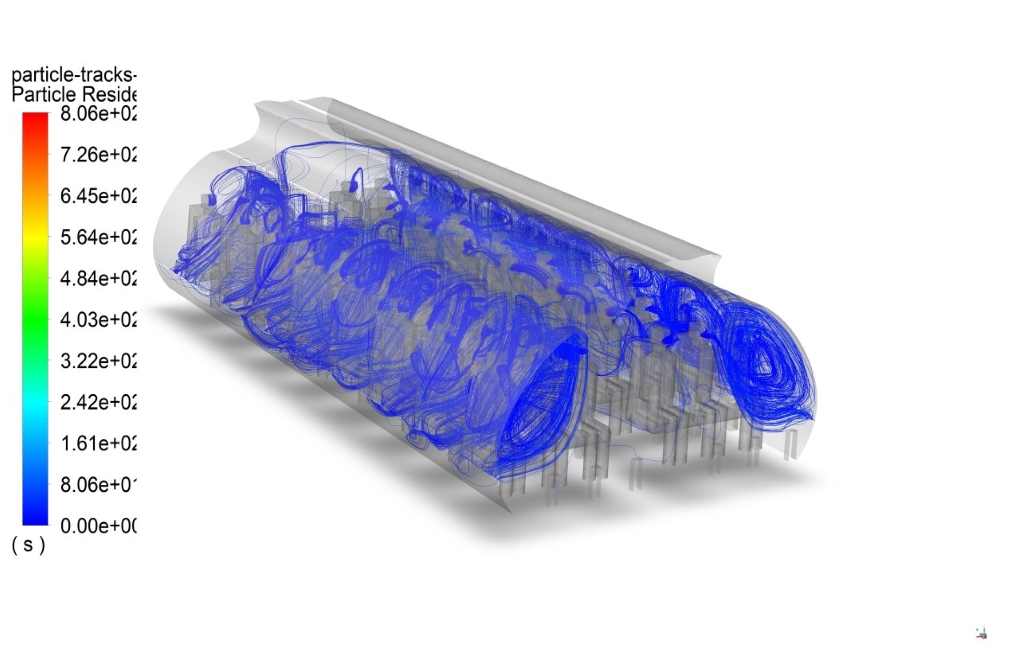
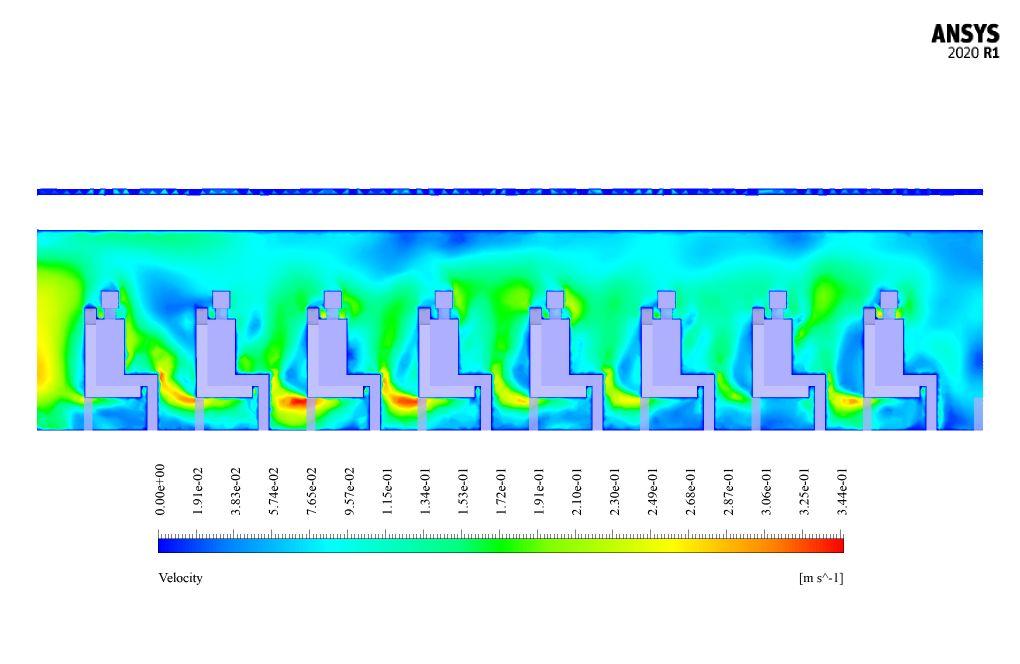
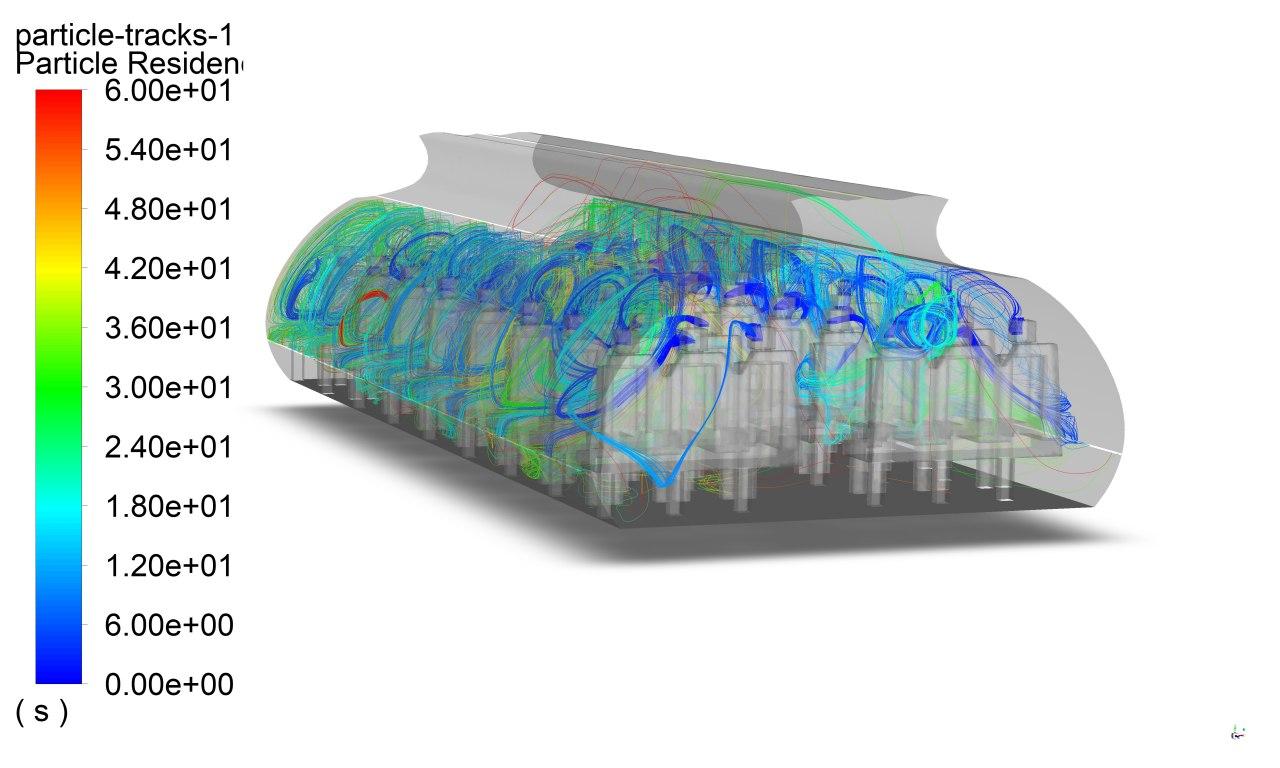
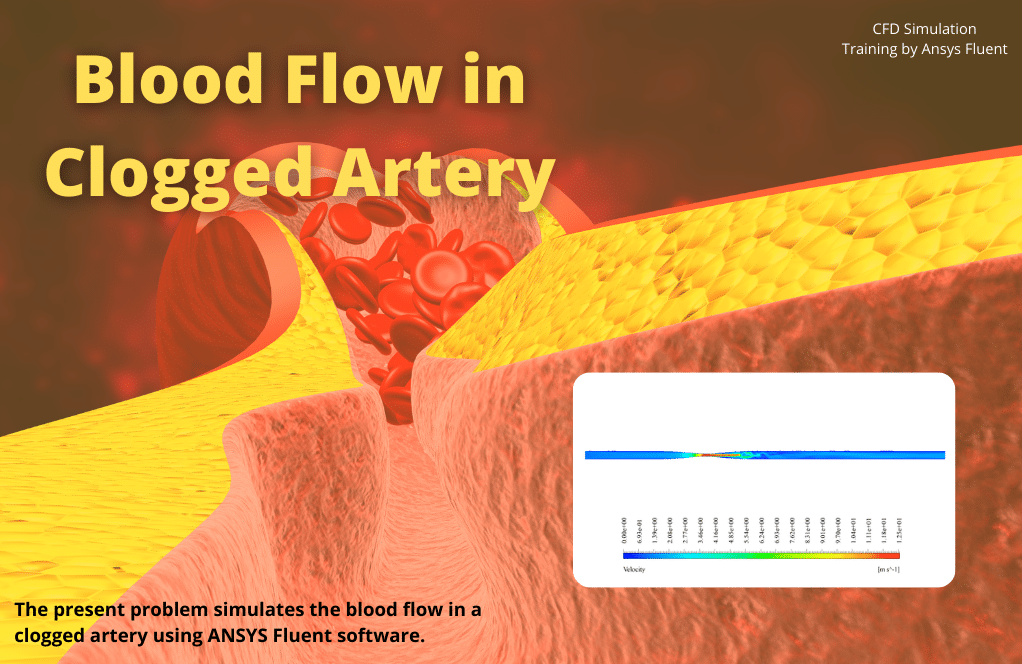


Dr. Tod Dicki PhD –
Excellent tutorial for visualizing the breathing patterns and potential viral transmission on an airplane! The level of detail on airflow dynamics is commendable. I really felt like I could grasp the complexity of airflow and the importance of proper ventilation systems. The segmentation of the aircraft and precise settings used for virus particle simulation were laid out exceptionally well. It will definitely be beneficial for research and safety guidelines!
MR CFD Support –
Thank you for your kind words! We’re thrilled to hear the tutorial exceeded your expectations and provided valuable insights. It’s gratifying to know our work contributes positively to the important field of public health and safety. We appreciate your positive feedback and are motivated to continue delivering high-quality CFD training materials!
Prof. Coy Hackett –
I found the application of the discrete phase model (DPM) particularly interesting in studying virus transmission within the aircraft. Can you share more about how it helps analyze the risk of transmission among passengers?
MR CFD Support –
Sure. The discrete model (DPM) allows us to simulate and track the behavior of individual coronavirus particles within the airflow of the cabin. By monitoring these particles discretely, we can observe the trajectories they take, their residence time in the air, and final deposition spots. This information is crucial in understanding how the virus may spread from infected individuals to others within the confined space of the aircraft. The DPM results help in assessing high-risk areas and guide us in making recommendations on improving air circulation systems or reconfiguring seating to minimize transmission risks.
Moises Bode –
What kind of filter does the airplane’s air conditioning system use to prevent the spread of the virus, and how effective is it in filtering out the coronavirus particles according to the simulation results?
MR CFD Support –
The simulation described does not specify the details of the air conditioning system filters used in the airplane. However, to evaluate the effectiveness of any air filters or purifiers installed in the aircraft in preventing the spread of coronavirus, one would have to input specific properties, like the Minimum Efficiency Reporting Values (MERV) or High Efficiency Particulate Air (HEPA) standards these filters meet, into the simulation. The results would then be analyzed to determine the filter’s effectiveness at capturing viral particles. Since these specifics are not provided, the simulation assumes a basic flow of fresh air without detailing the filtration’s impact on virus transmission.
Enrico Abshire –
I was impressed by how the simulation captures the transmission of droplets in an airplane cabin. Are any recommendations provided based on the findings to improve air safety?
MR CFD Support –
Thank you for your positive review of our Coronavirus Patients Breathing in an Airplane simulation. The purpose of the simulation is indeed to understand the dynamics of droplet transmission in confined spaces such as aircraft cabins. While the simulation rigorously quantifies transmission risk under various conditions, actionable recommendations to enhance air safety would usually derive from interpreting these findings. This might involve assessing different ventilation strategies or seating arrangements. Unfortunately, based on the provided data, specific recommendations are not detailed here. For elaboration on strategies or tailored advice, information would likely need to be gleaned from further analysis or consultation with public health experts.
Gerald Pagac –
Is it possible to implement any methods or additional equipment in the simulation to reduce the spread of the virus within the airplane?
MR CFD Support –
In the simulation study of virus spread within an airplane, methods such as increasing the airflow rate of the fresh air system, optimizing the direction of airflow to establish a better air-purification effect or the introduction of high-efficiency particulate air (HEPA) filters in the ventilation system can be considered to reduce the spread of the virus. These scenarios can be tested by modifying the boundary conditions and source terms within the CFD simulation to observe the changes in virus particle distribution patterns.
Prof. Kristopher Waelchi –
I found the ‘Coronavirus Patients Breathing in an Airplane’ CFD simulation extremely insightful! It helps to visualize how airflow patterns can impact virus transmission inside an aircraft cabin. Excellent work in encapsulating an important present-day scenario.
MR CFD Support –
Thank you for your positive feedback! It’s gratifying to hear that you found the simulation insightful and relevant to current health and safety concerns in air travel. Our team strives to develop simulations that are not only technically comprehensive but also address real-world issues. We appreciate your remarks and look forward to providing you with more valuable simulations.
Hilma Torp –
In this simulation, how are the virus particles tracked, and how does the model ensure accurate representation of virus spreading within the airplane cabin?
MR CFD Support –
In the simulation, the virus particles are tracked using the Discrete Phase Model (DPM) which allows for discrete mass of particles to be considered within the continuous fluid flow of the cabin’s air. The accuracy of virus spread is ensured by defining specific properties of the virus particles, such as size, temperature, velocity, and flow rate, emulating conditions conducive for the virus to spread from the simulated breathing of infected passengers.
Mrs. Aliyah Davis –
I appreciated the level of detail in the ‘Coronavirus Patients Breathing in an Airplane Simulation’ tutorial. The step-by-step guide was thorough, providing clarity on setting up the DPM model and defining the virus particles’ characteristics so accurately. It certainly heightened the confidence in the results. Great job MR CFD Company on such an insightful and relevant study!
MR CFD Support –
Thank you for your kind words! We’re glad that you found the tutorial detailed and helpful. At MR CFD Company, we strive to provide comprehensive and accurate simulations that can be applied to real-world scenarios. Your feedback is highly appreciated, and we’re delighted to know that our products meet your expectations!
Evert Rempel –
The practical aspects of the study have piqued my curiosity. How is the relevance of the simulated data assured in comparison to the true behavior of aerosols from human breath to actual in-flight conditions?
MR CFD Support –
To ensure the relevance of the simulated data to real in-flight conditions, detailed models like the Discrete Phase Model (DPM) are used to simulate the behavior of aerosols from human breath. This model considers factors such as particle size, temperature, velocity, and release rate, which are calibrated based on empirical data from similarly controlled experiments. Evaluations and validations against experimental data from contained environments with aerosol releases offer reliability to the simulation outputs.
Myrna Wunsch DDS –
The tutorial sounds impressive and comprehensive. Could you please explain how you ensured the droplet dispersion from the mouth in the simulation accurately represents real-life scenarios?
MR CFD Support –
In the tutorial, we used the discrete phase model (DPM), which is suitable for tracking and analyzing discrete particles such as respiratory droplets in a continuous fluid flow like the cabin air. We modeled the virus particles as inert particles injected through the mouth. We defined specific particle diameters and velocities to closely replicate the characteristics of respiratory droplets expelled during breathing. These parameters were set based on scientific research and studies regarding respiratory droplet size and velocity in breathing and talking scenarios. Thus, we endeavored to simulate a realistic dispersion of virus-laden droplets in an enclosed cabin environment.
Gideon Mueller –
Just wanted to say I am very impressed with the level of detail in the Coronavirus Patients Breathing in an Airplane simulation. Fascinating study that is of great importance during these times. Great use of CFD technology.
MR CFD Support –
Thank you for your kind words and positive feedback about our simulation product. We’re delighted to know that you appreciate the detail and significance of our study on the transmission of respiratory droplets in an aircraft. It’s motivating to see our efforts recognized by users like you!
Delmer Huel –
The tutorial was very thorough and informative. It’s fascinating to see CFD applications to real-world problems like the spread of coronavirus in an aircraft. It’s clear that MR CFD has put considerable effort into making these complex simulations accessible for learning.
MR CFD Support –
We truly appreciate your positive feedback and are glad to know our efforts are making a difference in advancing applied knowledge. If you need any further assistance or have more questions, feel free to reach out. Thank you for choosing MR CFD!
Courtney Schuster –
What are the primary methods used to prevent the spread of coronavirus particles within the airplane simulation?
MR CFD Support –
In this simulation, the primary method used to prevent the spread of coronavirus particles is the aircraft’s air conditioning and circulation system. This includes the flow of fresh air from the airplane’s ceiling and outlets under each passenger’s seat, which helps to dilute and remove viral particles effectively.
Bert Littel –
Fantastic detailed simulation! Can it also measure the effectiveness of face masks in reducing disease transmission in such an enclosed space like an airplane?
MR CFD Support –
Thank you for your positive feedback! As a customer, your reviews are highly essential. Regarding your question, while the simulation described does not specifically talk about measuring the effectiveness of face masks, it certainly could be adapted to include face masks as an additional parameter. The computational model would require modifications to account for the filtration efficiency of the masks and their impact on the airborne particle trajectories.
Ms. Cecile Botsford IV –
I was particularly impressed by how the simulation could capture the intricate details of virus particle dispersion from an infected passenger’s breath inside an airplane cabin. It clearly highlights critical points for enhanced safety measures.
MR CFD Support –
Thank you for your feedback! We’re glad to hear that the simulation met with your expectations and provided valuable insights. Ensuring safety and understanding airflow dynamics in enclosed spaces, such as airplane cabins, is crucial, and it’s great to know that our product could contribute to this understanding.
Octavia Huel –
Does this simulation also take into account the effect of passengers moving around in the airplane, or is it strictly considering passengers seated and breathing in a stationary position?
MR CFD Support –
The simulation described strictly considers passengers seated and breathing in a stationary position. Motion such as walking or moving around in the airplane is not accounted for in this particular simulation scenario.
Mr. Jake Ankunding –
The review is full of praises for the detailed simulation setup! Can we use this model to evaluate the effectiveness of different mask designs on potentially lowering the spread of the virus in the cabin?
MR CFD Support –
The simulation model detailed in your review simulates the spread of viral particles in an airplane cabin, focusing on respiration without a mask. To evaluate different mask designs, modifications would be required to include the mask’s physical filtration properties and fitment. This additional complexity could be integrated into the model to study the effectiveness of masks, but that would be a separate simulation study tailored specifically for that purpose.
Shanon Wolf –
The simulation for virus spread in an airplane seems very comprehensive! It must have been a challenge to accurately model the airflow and patients’ breathing. Congrats on a job well done!
MR CFD Support –
Thank you for your kind words! We are glad to hear that you appreciate the depth and accuracy involved in creating the virus spread simulation within an airplane environment. It was indeed a challenge, but one that we believe provides valuable insights into the safety measures needed in such scenarios. If you need further information or have more specific queries about this or any other project, do not hesitate to ask.